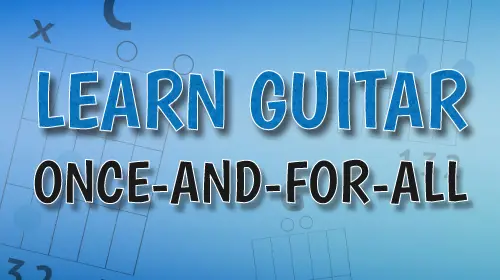4 MOST COMMON Chord Progressions You NEED to Know!
In this lesson, I’m going to teach you the 4 most common chord progressions that you can use to play by ear, write songs, play in any key and more. I’ll also show you the Nashville Number System in an easy way, so even as a beginner you can get the most from these easy chord progressions on guitar!
These popular chord progressions are found in thousands of hit songs and practicing them will not only improve your chord switching ability, but also help you begin to build your ear. Being able to play by ear basically entails recognizing chord progressions, and these 4 are a great start as you’ll find them all over the place!
Once you can play one of these progressions, you could simply hum a melody and the songwriting process will begin! The possibilities are literally endless, especially once you add in the easy theory that I’m going to teach you, that will allow you to use these progressions in any key. If you’ve ever wondered what those roman numerals are for, this lesson will show you in an easy-to-understand way that’ll give you PRACTICAL knowledge and immediate ability to use what you’ve learned.
TABLE OF CONTENTS
- 0:00 – INTRO
- 1:00 – What Is A Chord Progression?
- 1:35 – Why Learn Chord Progressions?
- 3:42 – #1) THE Most Common Progression
- 5:06 – Difference In “FEEL”
- 6:16 – Essential Theory: Nashville Number System
- 11:21 – #2) Doo-wop Progression
- 13:21 – #3) Country Time!
- 15:15 – #4) Feelin’ Minor
- 17:12 – Farewell Message
Before we learn any of these incredibly useful progressions, I’d like to answer a couple of questions that you might have.
What is a chord progression?
A chord progression is simply a sequence of chords that sound good together. We can get theoretical, and we do in the video a little bit, but that’s really all there is to it.
Why learn chord progressions?
They are the basis for all your favorite songs. And if you want to create your own music, they’re an amazing starting point. They’re also great for learning how to play by ear. This is one of the most fundamental parts of becoming a solid musician.
Progression 1: G D Em C
The first chord progression that I want to cover is literally the most common. progression. ever. Here is just a short list of songs that you would find using this chord progression:
- Journey – Don’t Stop Believing
- John Denver – Country Roads
- James Blunt – You’re Beautiful
- Jason Mraz – I’m Yours
- Elton John – Can You Feel The Love Tonight
- Maroon 5 – She Will Be Loved
- The Beatles – Let it Be
- Red Hot Chili Peppers – Under the Bridge
- Bob Marley – No Woman No Cry
Trust me, there are 1000s of popular songs that contain these chords in this sequence!
Now, the difference between all those tunes, is the feel, the speed of the song, the intensity at which you play it and, also, the strumming pattern. Another difference between these songs is the key.
We can play this chord progression in any key – it’ll use different chords in each key – but it still has the same signature sound. One of my main focuses in this lesson is to teach you how to change chord progressions from one key to the next, using the Nashville Number System. It’s one of the most powerful tools in music. If you ever learn one thing about theory, this should be it.
The three remaining chord progressions are all incredibly useful in their own right.
Progression 2: G Em C D
- Ben E. King – Stand By Me
- Ed Sheeran – Perfect
- David Bowie – Let’s Dance
- Righteous Brothers – Unchained Melody
Progression 3: E A E B7
- Johnny Cash – I Walk The Line
- CCR – Down On The Corner
- Buddy Holly – Every Day
- Chuck Berry – Johnny B. Goode
- The Little Mermaid – Kiss The Girl
Progression 4: Am C G D
- Green Day – Boulevard of Broken Dreams
- The Crannberries – Zombie
- The Who – Behind Blue Eyes
- Gary Jules – Mad World


